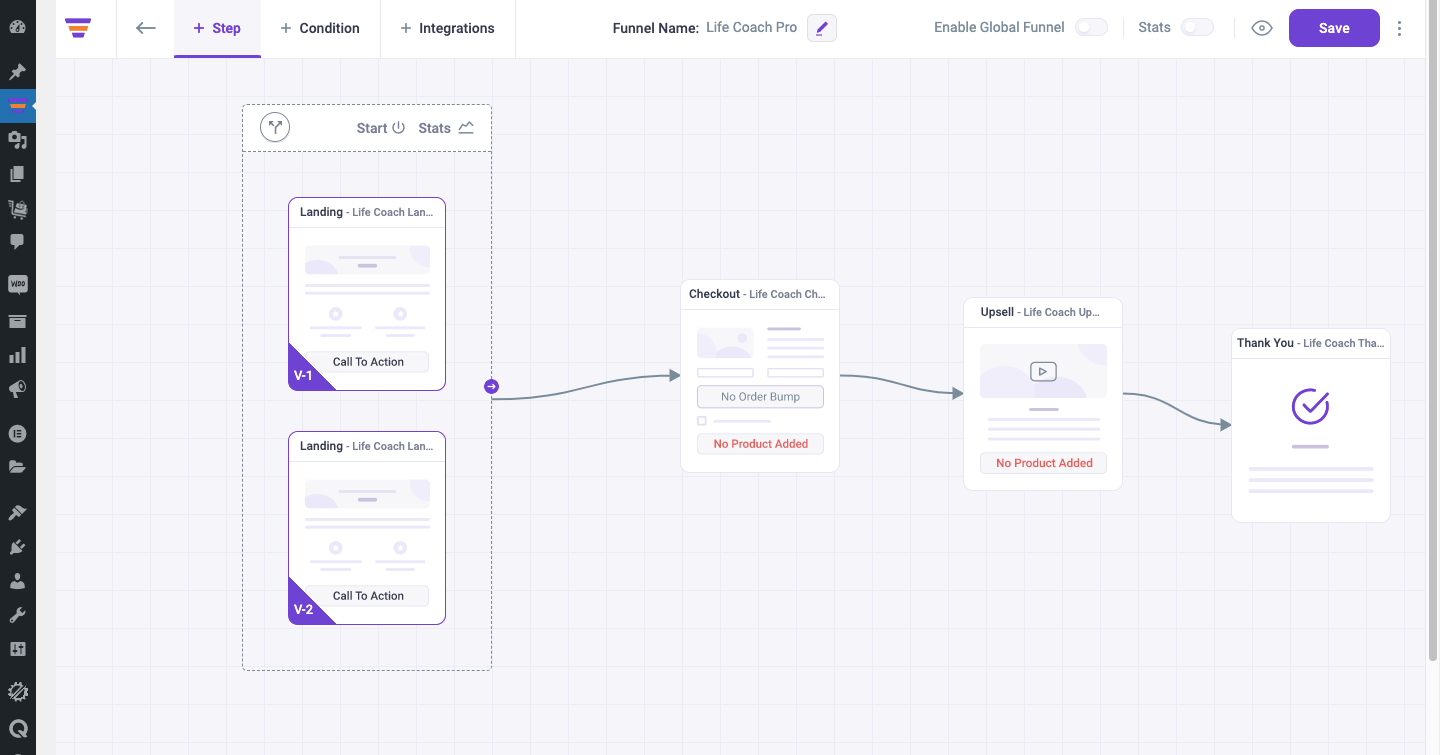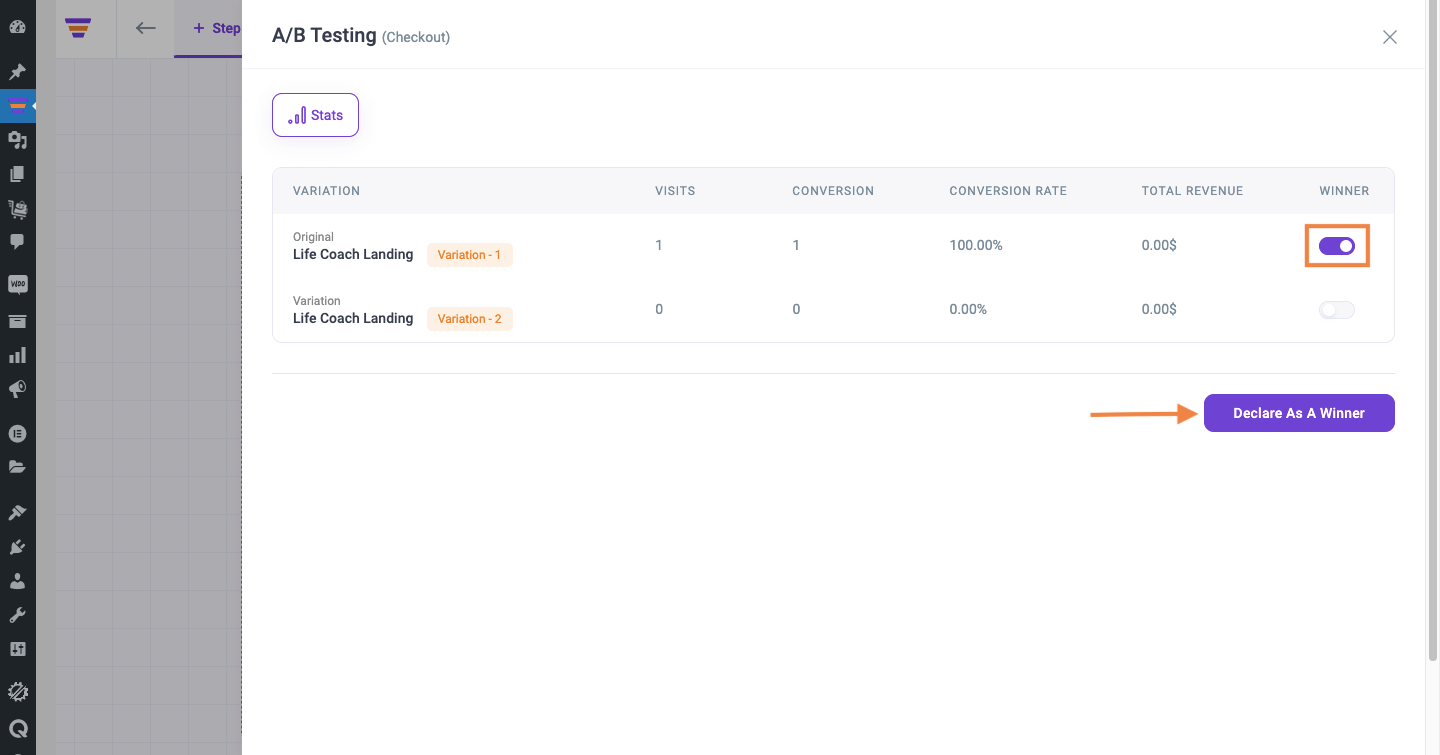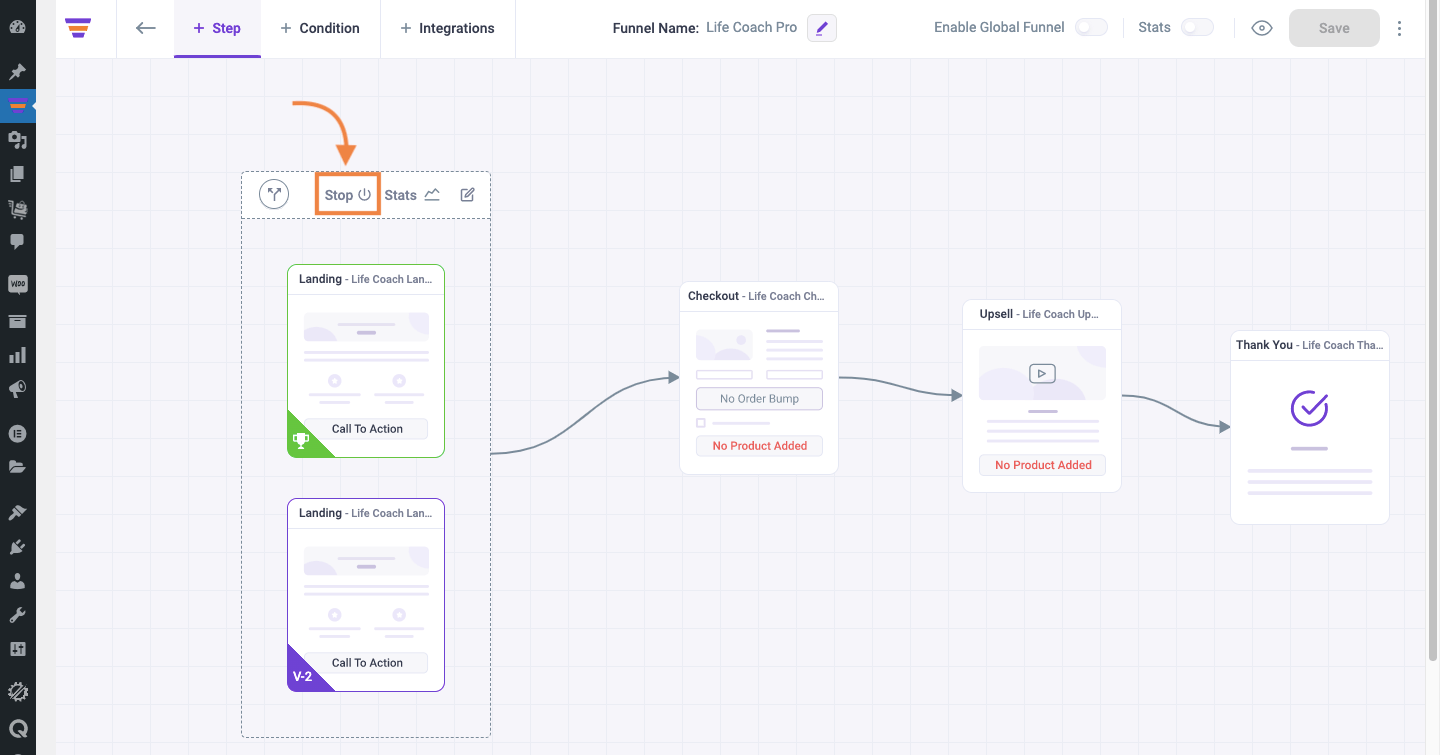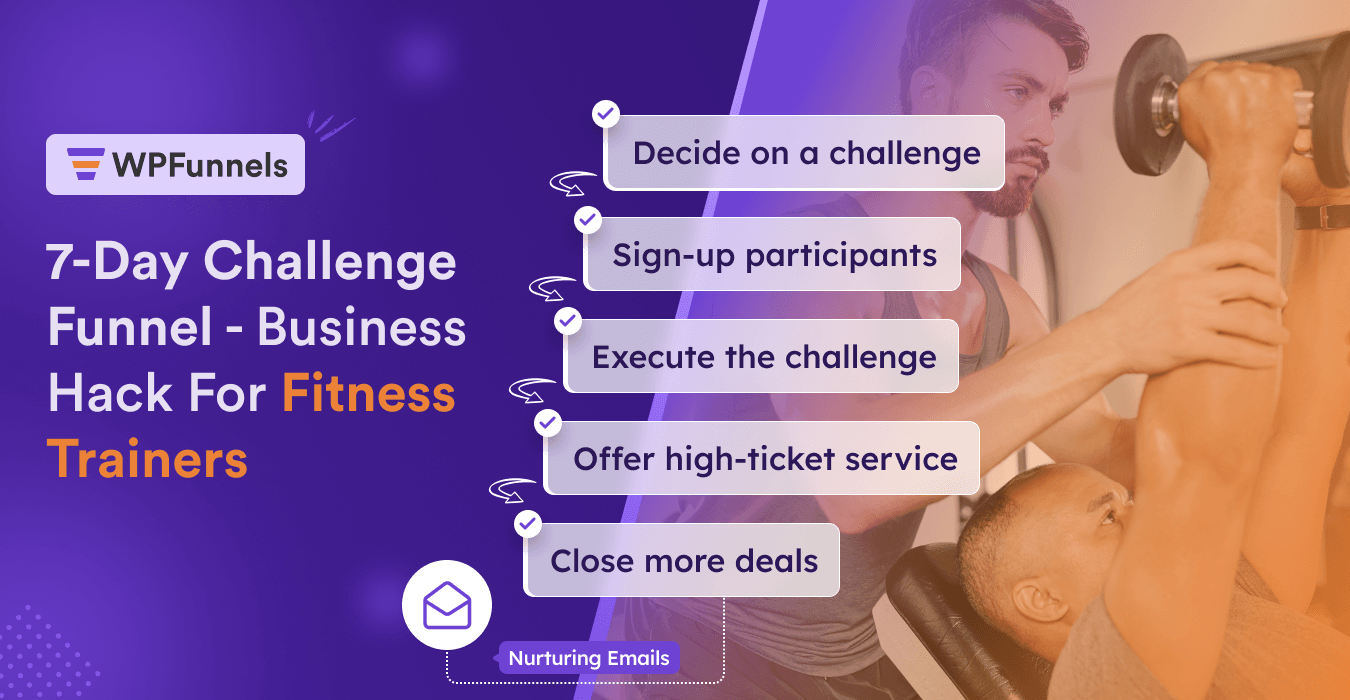If you own an online business, then you probably already know how important it is to set up a well-planned sales funnel that will help to convert more products into leads and sales. However, a big challenge here is to devise the right landing page copies or funnel page designs that may trigger a profitable conversion rate.
Now, a crucial part of running sales funnels is continuous optimization by improving copies and page designs from time to time. And the best approach to do this is by using A/B Split Testing.
According to 99firms, 70% of businesses saw increased sales from A/B testing landing pages.
Today, we will look at how you can use A/B split testing effectively to optimize your sales funnel for maximum conversion rate.
In this article, we will focus on highlighting the areas where you can run split tests for landing pages, checkout pages, and offers.
After reading this article, you will be able to plan your split-testing ideas and start optimizing your sales funnels actively.
So let’s begin.
What is A/B Split Testing, and Why is it Important for Your Business?
Split testing, also known as A/B testing helps to determine the better one among two versions of a webpage. This is usually done bit by bit with small but meaningful changes.
Let me explain with an example.
Suppose you have a sales funnel for selling 3 of your popular paintings. Now, let’s say your funnel landing page has a conversion rate of 3%, and you want to increase it.
And upon observation, you decided that changing the CTA button color could be a good way to have more people notice it and convert.
However, simply making the change could be risky. What if you change the color of the CTA button, and it turns out to result in an even lower conversion rate rather than increasing it?
To avoid this mishap, you run a split testing campaign. Basically, you create two versions of the same page – one with the current CTA button color and another with the new CTA button color.
Then, you partially distribute some traffic to the page with the new CTA button color (maybe 20% off your traffic) for two weeks. The rest of the traffic will still go to the initial page you have so that your business is not largely affected.
If it’s a brand new page and you have no data on its conversion rate, then you may choose to distribute the traffic 50/50.
Similar to this example, you can make changes to other elements of the funnel page and run split tests to find out which one works better.
The best way to get successful results from A/B split testing is to make small changes and run split tests for each rather than making a lot of changes at once.
For example, if you change the title, CTA button color, and the Hero section image all at once for split testing, you won’t be able to determine which one had the highest impact on increasing conversions. But if you do one at a time, you might see that one of the three changes probably had rather a negative impact.
Depending on your funnel strategy, there could be various steps included. You have to run separate split-testing campaigns for each of the steps to increase the performance at every stage of your funnel.
Nevertheless, the sole purpose of split testing is to determine the best improvements you can make in your funnels in terms of page content, design, and offers.
Actionable A/B Testing Ideas to Improve Your Funnel Conversion Rates
Your funnel strategy may have various purposes, such as lead generation, increased AOV, or increased products sold.
And you could choose to have various types of pages included. The most common page types included in a complete funnel include a landing page, checkout page, and offer. And within this, you may have different offers for lead generation, order bumps, or upsells.
In the next few sections, you will learn the various types of changes you can focus on when willing to run A/B testing campaigns for optimizing your funnel performance.
Let’s explore ideas specific to the page types and offer types to help you get a better understanding of where to start and how to proceed with the improvements.
1. A/B Testing For Landing Pages
Among all the pages in a funnel strategy, the landing page has the highest number of elements you can work on for CRO.
You will find tons of elements that may trigger prospects to make decisions and take action.
Let us look at what you can focus on for A/B Testing.
1. Optimize The Headline:
Since the headline is the first thing a visitor will see, naturally, this is the first element of a landing page you need to improve.
For instance, if you’re promoting a marketing software, you may try split testing with two variations of its landing page – one with the headline, “Streamline Your Marketing Efforts with a Reliable Software,” and another with the headline, “Transform Your Marketing Strategy with a Reliable Tool.”
2. Improve Subheadlines:
Experiment with different subheadlines to see how they impact conversions. In this case, it’s better to take different perspectives into consideration.
For example, in one variation, you may have subheadlines that are focused on product benefits (e.g. “Faster Execution With Less Effort”), whereas in another variation, you may have subheadlines that are focused on pain points (e.g. “No More Struggle With Confusing Platforms”).
3. Call To Action (CTA) Optimization:
In any funnel step, whether it is for lead generation or sales, the CTA acts as a crucial element. And there are various ways you can think of improving it through A/B testing. Try testing different CTA text, button colors, button size & shape, and button position.
For example, if you’re promoting a webinar, you may use the CTA “Register Now” on one variation and “Join the Webinar” on another.
4. Landing Copy Strategies:
The landing page copy is crucial to help you devise a proper transition for a prospect to convert. Depending on whether you are doing lead generation, sales, or affiliate marketing, the copy format may vary depending on your strategy. You may try various approaches, such as testing with long-form copy versus short-form copy or using different formats, such as using bullet points in one variation while using paragraphs in another.
If you have any specific promotion going on, let’s say a limited-time discount, you can test by alternating copies for urgency, such as “The offer ends in 3 hrs” vs. “Only 3 hrs left to get the offer.”
However, it is highly advised that for A/B testing, you make changes to a small portion of the copy for split testing if you already have an existing page that’s performing. If you want to do a full revamp of the copy, that would also mean the page design will change as well. So you have to decide if you want to invest such resources in this.
5. More Attractive Visual Content:
You may experiment with different forms of visual content or different variations of images, videos, or GIFs on your landing page.
For instance, if you’re promoting a fitness program, you can try testing variations, such as a video showcasing the workouts vs. an image highlighting the before-and-after stage of someone who has completed the program.
6. Form Variations:
If you are collecting leads via a form, then you may try variations of a form either in terms of design or in terms of the data you collect.
2. Checkout Page Split Testing
The checkout page is often ignored by marketers who expect that since a user is here, a simple checkout page is enough to complete the transaction. But his is far from true.
Over 70% of customers tend to abandon the cart, with almost 3 out of every 10 customers leaving the site empty-handed even after visiting the checkout page.
It’s not possible to avoid cart abandonment completely, but you can definitely look for ways to optimize the checkout page for maximum closing rate and increased order value.
Let us look at various areas you can work on to optimize your checkout page.
1. Warm Headline & Phrase:
You might think the headline of a checkout page can simply be “Checkout.” Yes, it can, but it’s not the best one. Rather, you can be a bit more creative with the headline along with a good catchphrase to trigger the customer to complete the purchase.
For example, you could use the headline, “Great Choice!” and then a phrase, “It’s almost done. Just one step left to place the order.” This will keep the buyer positive. But then, you can also do split tests with a second variation of the headlines and phrases, such as Headline: You Are Awesome! and Phrase: You made a perfect choice and will love it!
2. Checkout Page Layouts:
You may experiment with different Checkout page layouts to see which one helps to reduce checkout abandonment.
For example, you may try using the two-column layout in one variation while using a multi-step checkout with 3 steps on the other variation to try and make it more distraction-free. This will help you determine which one converts the most.
3. Experiment With The “Place Order” Button:
Most checkout forms have a “Place Order” button that the customer may click to proceed with the payment. Well, you can experiment with this button by split testing with different colors and button texts.
For example, you may keep the main variant with the button text “Place Order” while creating an A/B variant with the text “Order Now.” (We tried it ourselves, and the second one delivered 30% more results.)
4. Form Design & Typography Enhancement:
You may try using different border colors for the fields or different field formats such as floating field vs static field with placeholder and labels. You may even try changing font color and sizes in multiple variations to see which ones work better.
5. Include Or Exclude Social Proof & Trust Badges:
It is always advised to keep the checkout page distraction-free, in some businesses, including social proof and trust badges can be an advantage. In this regard, you can do a split test where one variation will not have any social proof or trust badges, while another variant will have both. Meanwhile, you can also try including only social proof and no trust badges vs only trust badges and no social proof.
6. Different Offer Propositions During Checkout:
You may run a split test by offering different types of order bumps in multiple variations with changes to order bump offer, discount amount, or order bump position to see if any of these convert for higher order value. But do not make any changes that may take the buyer away from the checkout page, for example, it is not wise to give product suggestions on the checkout page without the option to add it with a single click.
3. Order Bump Offer A/B Testing
An order bump is a special offer you can make right on the checkout page which a buyer can add to the order with a click before making payments.
The idea is to offer something relevant that doesn’t cost too much while providing enough information on the offer so that the buyer doesn’t have to visit the product page.
Now, while this is a great concept, it often doesn’t convert if not done right. Hence, you can run specific A/B testing campaigns to find out which order bumps may perform well.
Here are a few ways you can split test for order bumps.
1. Experiment With Different Product Offers:
Since an order bump is most successful if you can offer something relevant that costs less, you can try making offers on different products on different variants.
For example, let’s say you have a beauty store for women and a buyer is about to purchase a Peel Off mask. Then on the order bump for one variant of your checkout page, you may offer a face wash from the same brand. And on the second variant, try offering a beauty cream from the same brand. For this case, you may distribute traffic equally, i.e., 50/50. Then after 2 weeks, you may determine which one converted more and make that as the regular order bump offer along with the Peel Off mask.
Experiment with different products as order bumps. For instance, you could try testing a higher-priced product versus a lower-priced product. Another option would be to try and offer different better alternatives. For example, if someone is buying a backpack, you may set two checkout variants where each would have a different backpack that costs more and has better quality than the one the buyer is about to purchase.
2. Tweak Discount Amount:
While order bumps offer to convert more with discounts, sometimes it is not necessary to provide a discount. But to confirm this, you may try split testing with different discount amounts vs no discount at all.
In this case, you may rather create four checkout page variants – one with no discount on the order bump, and three with 5%, 10%, and 20% off respectively, for the same product. Distribute the traffic equally for a couple of weeks and then settle for the one that converts the most. You will be surprised to see that a higher discount doesn’t always bring more conversions.
3. Test With Different Order Bump Designs:
You may try testing between different layouts, Color schemes, Font styles, and Images on your order bump to determine which design resonates best with your audience.
4. Split Test With Multiple Order Bump Offer Copy:
For the same order bump offer, try multiple variants with different content about the product.
For example, in one version, you may highlight the end results the product will bring, while in the second version, you may set a bullet point of features they will get with it.
5. Try Order Bumps On Different Positions:
Since an order bump can be placed in various places on the checkout page, you can do an extensive A/B testing campaign to see which position helps to convert more. Plus, you may also try placing multiple order bumps vs. single order bumps on various positions.
These tests will help you choose the best position to place order bumps on your checkout page.
4. Offer Page A/B Testing Ideas
An offer page can be similar to a landing page, but usually, it is completely focused on the offer at hand. In a new-generation sales funnel, the most successful offer strategy is one-click upsell & down-sell offers after checkout, i.e., post-purchase offers.
In this regard, you can try different A/B split testing attempts to come up with the highest converting format for your offer page.
Here are a few ideas to focus on.
1. The Offer Page Hero Section Layout:
An offer page’s success is highly dependent on the first impression it can create on the buyer. So it is crucial to make sure you have the best hero section design & layout possible.
Hence, it is advised to constantly run new A/B testing campaigns to improve the Hero section on the offer page. You may try experimenting with different headlines, images, or designs. You may even try small changes such as using bullet points on product benefits vs using a video to highlight the product benefit in the hero section.
The main goal of these will be to see which variant keeps the customer from not rejecting the offer. Whichever will generate more offer acceptance will be considered the successful variant.
2. Different Offer Content Strategy:
You may choose to go for a single view page vs VSL sales letter vs long-form content. The idea is to present the same offer using different content strategies on each variant to see which one converts more.
3. Experiment With Product Details:
Some products sell more when people know how popular its, while others sell more if they offer more value for money. On one variant of the offer page, you may try including product ratings, and quantity sold, while not including them in another. Since it’s an offer page, you should only show the product details that can trigger decisions.
4. Other Common Experiments:
Some common experiments are always done for offer pages such as comparison between various CTA button text and design, headline variants, and different images used. You may try running split tests for these to get good results.
How To Determine The Split Testing Traffic Distribution
Once you run an A/B Testing campaign, you then need to determine a winner, i.e., the one that worked best.
But there are more things involved. When preparing for split testing, you first need to understand how you will choose to distribute traffic. We recommend two approaches:
Approach 1 – The Extended 80/20 Split Testing
This an approach that is more suitable for pages that are already up and running and you have the data on its conversion rate.
Using the Extended 80/20 A/B Testing method, based on the 80/20 rule, you will be able to accurately test a second variant without losing much business in the process.
Since your current page is already getting you results, you don’t want to hamper the flow just to run experiments. Rather, you use this approach to devote limited opportunities to a variant (i.e. only 20% of the traffic) while keeping the original page with the highest traffic generation (i.e. 80% person). In this case, if the experiment fails, you won’t have any significant loss.
Here’s what you do:
- Create a variant to your existing page or offer.
- Distribute 20% of the traffic to the new variant while driving 80% of the traffic to the current page.
- If the new variant shows a better result after a week, reverse the traffic distribution and keep it like that for another week. Now the new page will have 80% traffic and the main page will have 20%.
- If the result shows a 10-20% more conversion from the new variant, then stop the A/B testing and set the new variant as the main page.
And that’s it.
You may then focus on making the improvements and planning the next A/B testing idea.
Approach 2 – The 50/50 Split Testing
The 50/50 Split Testing is exactly as it sounds – you drive traffic equally to all the A/B variants and find out which gets you the higher results.
This is commonly used for new pages or funnels, or for pages that aren’t performing too well and you want to find out why.
Here’s what you do:
- Create a page and then create a variant for it.
- Set the traffic distribution to 50/50.
- Find out which one converts more and then set it as the main page with 100% traffic.
And that’s it.
Remember, the main purpose of A/B testing is conversion rate optimization. Hence, only focus on experiments that you feel will affect conversion. It is not used to test trivial design changes or experiments with no goals.
Since you will be investing time and resources in it, it’s best to have a clear goal for every change you experiment with. And if done right, you can then be sure to have improved your funnels with data-driven decisions.
Remember, the key to successful A/B split testing is to focus on one element at a time and only test one variation against the original. This will allow you to accurately measure the impact of each change and make data-driven decisions to improve your sales funnel conversion rate.
How to Conduct Funnel Split Testing In WordPress?
There are a few great tools for conducting A/B split testing in general like HubSpot’s A/B Testing Kit or Google Optimize. But if you are using WordPress and don’t want to leave the comfort of it, you can use a Visual Funnel Builder that has an in-built A/B testing feature.
With WPFunnels, you can create another variation with just a click and start split-testing in minutes!
And guess what, you get to choose from 3 different options on how you want to create a new variation:
- Duplicate Variant – it will duplicate the existing funnel page
- Choose From Template – it will let you choose a pre-built template for the variation
- Start From Scratch – it will let you design another page from scratch
You can follow 3 easy steps to conduct funnel split testing in WordPress.
Step 1 – Create Other Variation
When you already have a funnel, move on to creating a variant. And whichever option you choose to create a variant, you’ll have your main page and variant page on the same funnel canvas for a clear view.

Step 2 – Select a Winner based on the Results
For defining the Split Testing results, you can either go for an Automatic Split Testing Winner Selection or Declare The Winner Manually by yourself.

Step 3 – Keep the Winner & Archive the Other Version
After the selection is done, you can stop the A/B testing and archive the variation which didn’t win.

So, this could be the easiest way for you to try Funnel Split Testing the first time your funnels.
Conclusion
You know how crucial it is to keep up to date with the latest funnel optimization tactics. A/B testing is a powerful approach to find out what’s not working and you get to improve them.
If you’re not already using A/B split testing in your business, now is the time to start. Don’t be afraid to experiment and try different variations to see what works best for your unique sales funnel. With each test, you’ll gain valuable insights and learn more about what drives conversions and revenue for your business.
So, take action today and start testing!







![Fitness Marketing: A Quick Guide Using Sales Funnels & Email Marketing [2024] 5 fitness marketing](https://getwpfunnels.com/wp-content/uploads/2023/08/A-Fitness-Sales-Funnel-2-1.png)

![Ultimate Guide to The Financial Advisor Sales Funnel [2025] 7 Financial Advisor Sales Funnels](https://getwpfunnels.com/wp-content/uploads/2024/06/Financial-Advisor-Sales-Funnels-Copy.webp)
![What is a B2B Sales Funnel - Steps, Tips and Implementation Guide [2025] 8 What Is A B2B Sales Funnel - Steps, Tips, And Implementation Guide](https://getwpfunnels.com/wp-content/uploads/2024/01/What-Is-A-B2B-Sales-Funnel-Steps-Tips-And-Implementation-Guide.webp)
![Stages Of An eCommerce Conversion Funnel And How To Optimize It [2024] 9 Stages Of An eCommerce Conversion Funnel And How To Optimize It](https://getwpfunnels.com/wp-content/uploads/2023/12/Stages-Of-An-eCommerce-Conversion-Funnel-And-How-To-Optimize-It.webp)
![Order Bump vs Upsell – What is Better to Increase AOV [2025] 10 Order Bump vs Upsell](https://getwpfunnels.com/wp-content/uploads/2024/10/Order-Bump-vs-Upsell-1.webp)